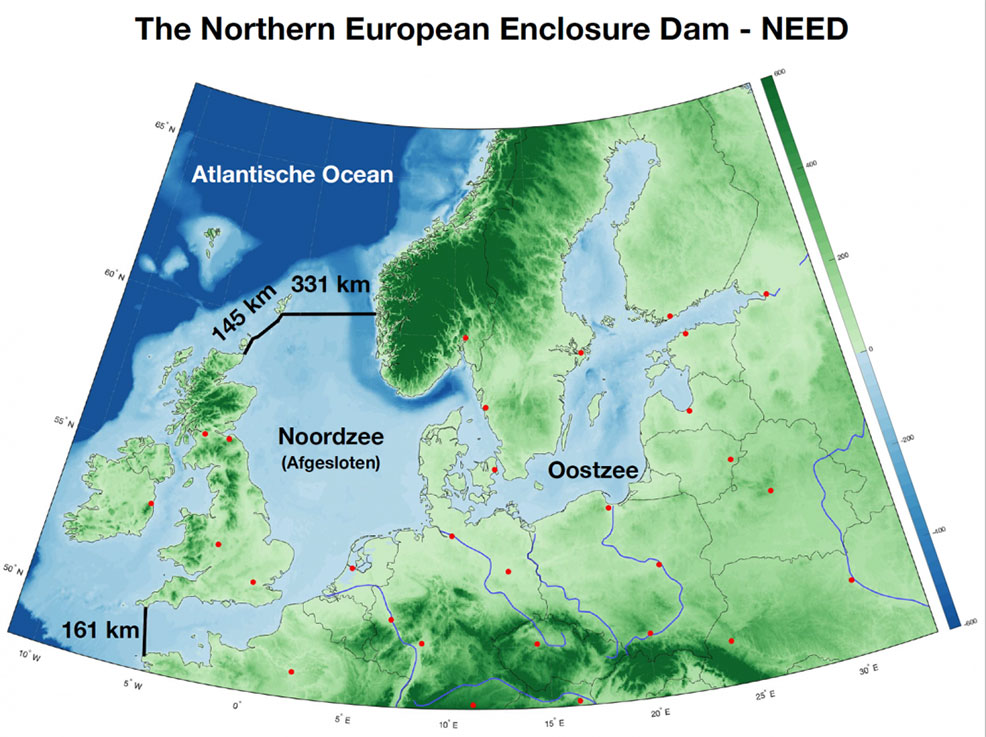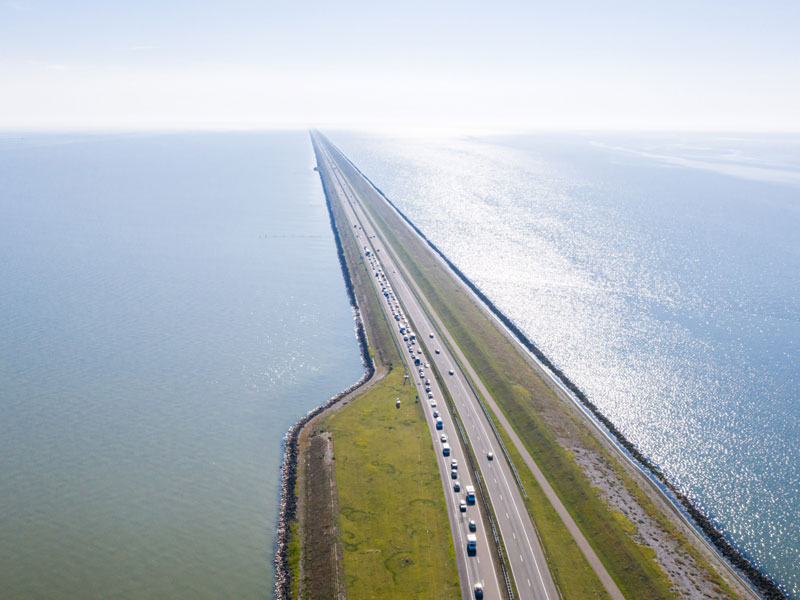
13th February 2020 Giant dams could protect Northwestern Europe from rising sea levels A pair of giant dams, fully enclosing the North Sea, could protect up to 25 million Europeans from rising sea levels, according to a new study.
Following our blog yesterday on the proposed bridge linking Scotland and Northern Ireland, another sea-based infrastructure project for the British Isles has now caught our attention. This one is an order of magnitude larger, with estimated costs of €250-500 billion – and would involve several other countries too. Dr Sjoerd Groeskamp, oceanographer at the Royal Netherlands Institute for Sea Research, along with his Swedish colleague Joakim Kjellson at GEOMAR in Kiel, Germany, propose a pair of giant dams, fully enclosing the North Sea off the eastern coast of Great Britain, as well as the English Channel. If such a megaproject were ever built, much of Northwestern Europe could be protected from rising sea levels. A structure measuring 476 km (296 mi) in length, between the north of Scotland and the west of Norway, would be joined by another of 161 km (100 mi) between the western tip of France and the southwest of England. "The construction of such a 'North-European Enclosure Dam' seems to be technically feasible," explains Groeskamp. "The maximum depth of the North Sea between France and England is scarcely one hundred metres. The average depth between Scotland and Norway is 127 metres, with a maximum of 321 metres just off the coast of Norway. We are currently able to build fixed platforms in depths exceeding 500 metres, so such a dam seems feasible too." The Netherlands already has an extensive system of hydraulic engineering projects to protect its coastline from the sea. The Delta Works, and the accompanying Zuiderzee Works (part of which can be seen in the photo below) have been described by the American Society of Civil Engineers as among the Seven Wonders of the Modern World.
Could an even larger-scale project be attempted during the next hundred or so years, perhaps funded by an international collaboration? The cost of building the so-called North-European Enclosure Dam would amount to only 0.1% of the gross national product, annually over 20 years, of the 14 countries that would be protected by it, according to Dr Groeskamp and his colleague Kjellson. "We estimated the financial costs for the construction of the dam by extrapolating the costs for large dams in South Korea, for example," says Groeskamp. They do, however, acknowledge the consequences of this dam for North Sea wildlife, the loss of income from North Sea fishing, the increased costs for shipping across the North Sea and costs of gigantic pumps to transport the river water that currently flows into the North Sea to the other side of the dam. These and other factors would need serious consideration. "The tide would disappear in a large part of the North Sea, and with it the transport of silt and nutrients," explains Groeskamp. "The sea would eventually even become a freshwater lake. That will drastically change the ecosystem and therefore have an impact on the fishing industry as well." But still, the project is at least technically feasible – and would gain added impetus from the accelerating impacts of rising sea levels, which are predicted to increase by 1 to 2 metres by 2100. Without action, the rising waters could displace more than 25 million people in Northwestern Europe. Ultimately, the description of this mega-scale dam is more of a warning than a solution, Groeskamp states: "The costs and the consequences of such a dam are huge indeed. However, we have calculated that the cost of doing nothing against sea level rise will ultimately be many times higher. This dam makes it almost tangible what the consequences will be; a sea level rise of 10 metres by the year 2500, according to the bleakest scenarios. This dam is therefore mainly a call to do something about climate change now. If we do nothing, then this extreme dam might just be the only solution." Hannah Cloke, Professor of Hydrology at the University of Reading, agrees that the plans appear technically viable. "I guess it depends on what timescale we're thinking of," she said. "If you look back hundreds and hundreds of years, then we've made some significant adaptations to our landscape, and the Netherlands is an example of that. We can, as humans, do amazing things. [...] I think it is really important that we keep thinking about these ideas, because the future looks very scary. If you look back into the 1940s in the UK, the Thames Barrier probably seemed equally ridiculous. It depends what happens in the next 20-30 years, how bad it gets, and then perhaps we will need something like this." With sea levels affecting the entire globe, many other regions beyond Northwestern Europe are likely to consider similar projects if climate change begins to race out of control. Perhaps in future centuries, our descendants will be capable of even greater feats of engineering – such as the New Atlantis Project featured in the Star Trek: TNG episode, Family. This truly enormous effort, commencing in the year 2367, aims to establish a new subcontinent on the Mid-Atlantic Ridge of the Atlantic Ocean. New Atlantis, while not a climate change adaptation, provides an interesting glimpse of the land reclamation projects that might be possible in the far distant future. A map is seen only fleetingly on a screen, but triggers our imaginations. Dr Groeskamp and his colleague Kjellson have submitted a paper to the American Journal of Meteorology, describing their work in more detail, which is due for publication later this month.
Comments »
If you enjoyed this article, please consider sharing it:
|








